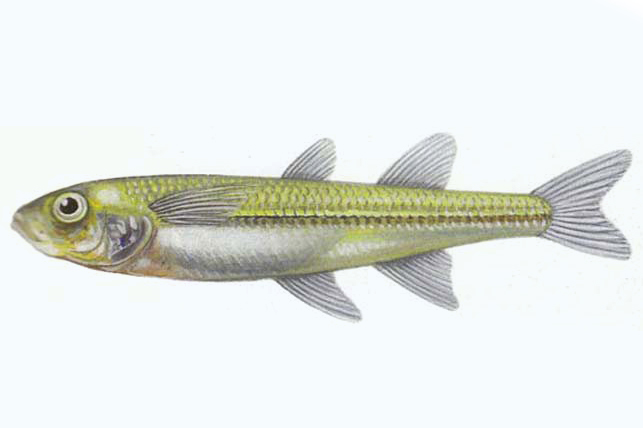Darling Hardyhead, Craterocephalus amniculus Crowley & Ivantsoff 1990

Illustration of a Darling Hardyhead, Craterocephalus amniculus. Source: Jill Ruse. License: All rights reserved
Darling Hardyhead, Craterocephalus amniculus Crowley & Ivantsoff 1990
More Info
|
Distribution |
Endemic to the Border Rivers, Gwydir and Namoi catchments of the Murray-Darling Basin above 200 m to at least 1,030 m, and the Hunter catchment between 50 to 330 m altitude - in New South Wales. Their distribution also extends into the Queensland part of the Border Rivers catchment. Occurs in a range of waterways from large rivers to small slow-flowing stream. Although found in a range of habitats including turbid to clear waters in small weedy pools to clear gravel-bottomed pools, the species often inhabits clear flowing streams with riffles and rapids and aquatic vegetation. |
|
Features |
Meristic features: Dorsal fin 1 V-VII (unbranched rays) + Dorsal fin 2 I, 5-7; Anal fin I, 5-8; Pectoral fin 11-14. Body slender, elongate; greatest body depth 4.0-5.3 in SL; mouth protractile, lips thin; gape restricted by labial ligament, one third of way along mouth; teeth few, moderately long and pointed, restricted to anterior part of both jaws. Scales small, almost circular, thin, but with circuli complete and obvious, appearing barely to overlap; scales usually absent from dorsum of head, or if present, well spaced, small and circular; scales absent from opercles; vertical scale rows 37-48; horizontal scale rows 14-18. Two short-based, well-separated dorsal fins; origin of 1st dorsal above origin of ventral fin; origin of 2nd dorsal above origin of anal fin; caudal fin moderately forked; pectoral fins positioned high on sides, near top of gill openings, elongate and pointed; ventral fins abdominal, elongate, pointed. |
|
Size |
To 5.5 cm SL |
|
Colour |
Dusky gold to pale above dark silvery midlateral stripe and silvery gold to pale below; abdomen, chin, opercles and eyes, silvery; top of head, snout and lower jaw very dark; caudal fin golden, dorsal fins dusky gold; anal fin pale gold; pelvic fins clear. |
|
Feeding |
Omnivore - mostly consumes algae, and insect larvae; diet may also include small crustaceans, gastropod molluscs, worms and fish eggs. |
|
Biology |
Breeds from September to February. Spawning occurs in pairs and females deposit demersal eggs amongst aquatic vegetation. Possibly an annual species. |
|
Conservation |
The Darling Hardyhead is threatened by habitat degradation including soil erosion, land clearing, removal of riparian vegetation, damage to riverbanks by livestock, river regulation and water extraction, and the presence of alien species such as Eastern Gambusia (Gambusia holbrooki), Goldfish (Carassius auratus) and Common Carp (Cyprinus carpio). |
|
Remarks |
This species has previously been mis-identified as C. eyresii and specimens from the Hunter River have tentatively been identified as C. amniculus but may be an undescribed species. |
|
Similar Species |
Most similar to C. eyresii but differs in scale counts. C. amniculus has 37-48 vertical scale rows versus 30-34 in C.eyresii and 14-18 horizontal scale rows versus 11-14 in C.eyresii. The head and body scales of C. amniculus are smaller than in any other Craterocephalus species. |
|
Etymology |
The specific name amniculus is from Latin meaning a small creek or stream, in reference to the habitat where these fish are often found. |
|
Species Citation |
Craterocephalus amniculus Crowley, L.E.L.M. & Ivantsoff, W. (1990). A review of species previously identified as Craterocephalus eyresii (Pisces: Atherinidae). Proc. Linn Soc. N.S.W. 112(2): 87–103 [88 fig. 1]. Cockburn R., Nemingha, NSW [31°07'S, 150°59'E]. |
|
Author |
Vanessa J. Thompson & Dianne J. Bray |
Darling Hardyhead, Craterocephalus amniculus Crowley & Ivantsoff 1990
References
Adams, M., Wedderburn, S.D., Unmack, P.J., Hammer, M.P. & Johnson, J.B. 2011. Use of Congeneric Assessment to Reveal the Linked Genetic Histories of Two Threatened Fishes in the Murray-Darling Basin, Australia. Conservation Biology 25: 767–776. doi: 10.1111/j.1523-1739.2011.01692.x
Allen, G.R., Midgley, S.H. & Allen, M. 2002. Field guide to the freshwater fishes of Australia. Perth : Western Australian Museum 394 pp.
Battaglene, S.C. 1985. Preliminary study of the fish resources of the Hunter Valley. Prepared for the Water Resources Commission of New South Wales by the Division of Fisheries, New South Wales Department of Agriculture, Brackish Water Fish Culture Research Station, Port Stephens.
Chessman, B.C. & Williams, W.D. 1974. Distribution of fish in inland saline waters of Victoria, Australia. Australian Journal of Marine and Freshwater Research 25: 167–172.
Crowley L.E.L.M. & Ivanstoff W. 1990. A review of species previously identified as Craterocephalus eyresii (Pisces: Atherinidae). Proceedings of the Linnean Society of New South Wales 112: 87–103.
Crowley, L.E.L.M. & Ivantsoff, W. 1992. Redefinition of the freshwater fish genus Craterocephalus (Teleostei: Atherinidae) of Australia and New Guinea with an analysis of three species. Ichthyol. Explor. Freshw. 3(3): 273–287
Ebner, B. & Raadik, T.A. 2001. Threatened Species Profile: Murray Hardyhead Craterocephalus fluviatilis. Australian Society for Fish Biology, Inc. Newsletter 31(2).
Faulks, L. 2010. A survey of the Hunter River catchment for the Darling River hardyhead and southern purple spotted gudgeon. Industry & Investment NSW, Port Stephens Fisheries Institute, Taylors Beach.
Lintermans, M. 2007. Fishes of the Murray-Darling Basin: An introductory guide. Murray-Darling Basin Commission, Canberra. 157 pp.
McDowall, R.M. 1996. Freshwater Fishes of South-eastern Australia. Sydney : Reed Books 2nd Edn 247 pp.
Wager, R. 1996. Craterocephalus amniculus. The IUCN Red List of Threatened Species. Version 2014.2.



